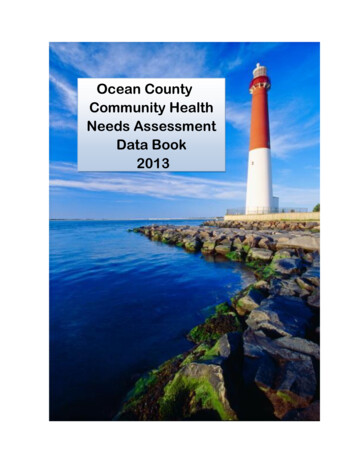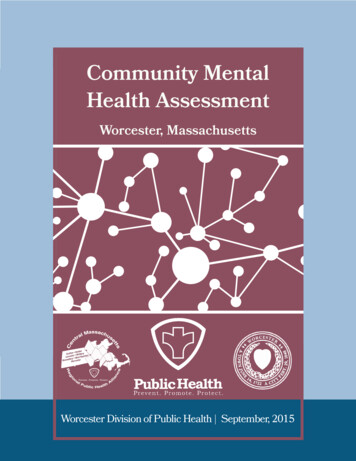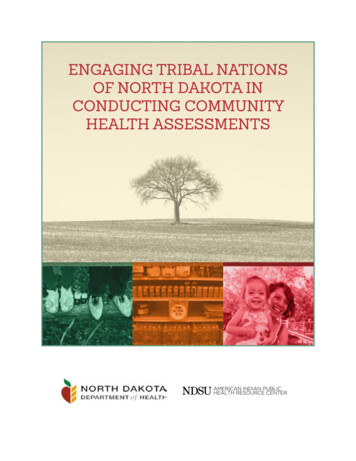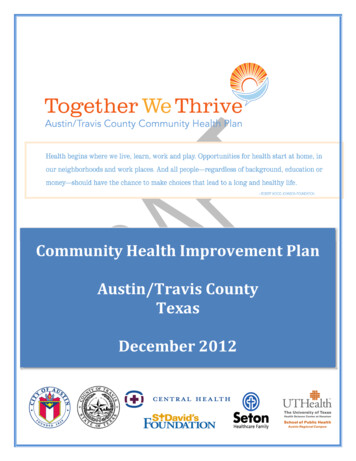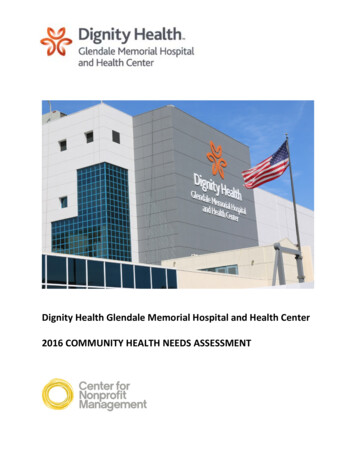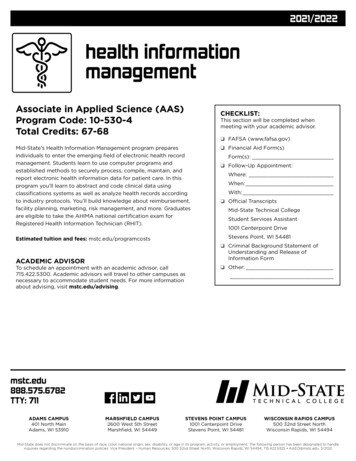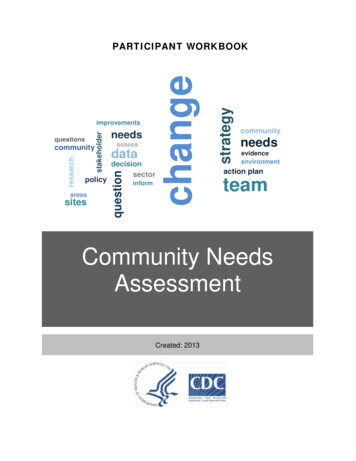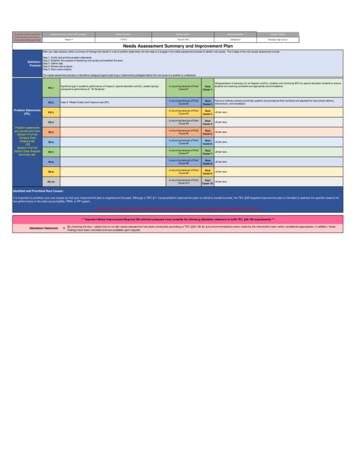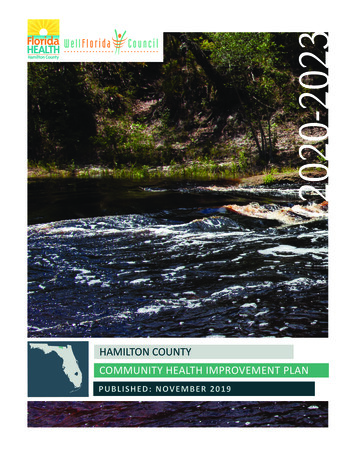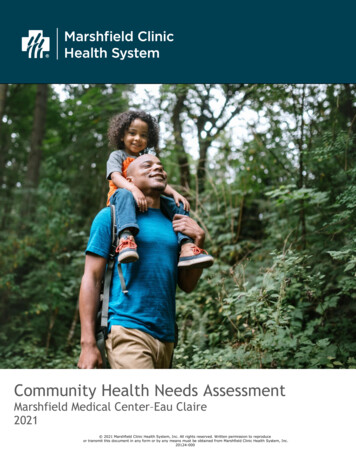
Transcription
Community Health Needs AssessmentMarshfield Medical Center–Eau Claire2021 2021 Marshfield Clinic Health System, Inc. All rights reserved. Written permission to reproduceor transmit this document in any form or by any means must be obtained from Marshfield Clinic Health System, Inc.20124-000
Table of ContentsWelcome Letter . 3Definition of Terms . 4Health System Overview . 6Hospital Overview. 6Our Community . 7Assessing the Needs of the Community . 8Addressing the Needs of the Community . 15Potential Resources to Address Health Priorities . 24Next Steps. 24Evaluation of the Impact of the Preceding Implementation Strategy . 26Appendix A: Individuals Involved in the CHNA . 29Appendix B: Community Health Survey . 30Appendix C: Community Health Survey Results . 33Appendix D: References . 34Marshfield Medical Center–Eau Claire Community Health Needs Assessment 2
Dear Community Members,Marshfield Clinic Health System’s mission is to enrich lives and create healthycommunities through accessible, affordable, compassionate health care. And thatincludes your community.We know that health is driven by much more than what happens in the doctor’soffice. Wherever and whenever possible through programs, services, public policy orother means, emphasis needs to be placed on addressing health choices beforemedical needs arise.That’s why the MCHS Hospitals Board, Inc., authorized governing body, has adoptedthis needs assessment on December 13, 2021.The Health System has collaborated with community partners to assess communities’health and needs. The process has included meetings, surveys, communityconversations, key informant interviews and a variety of data sources.This document summarizes these key findings. Electronic versions and companiondocuments can be found at: sThrough these collaborative efforts, the top health priorities identified through the2021 Community Health Needs Assessment process have been identified. MCHS willcontinue to support additional community health needs as they arise. The top healthpriorities for Marshfield Medical Center-Eau Claire are: Alcohol and Substance AbuseBehavioral HealthChronic DiseaseSocial Determinants of HealthWe hope you find this document useful and welcome your comments and suggestionsfor improving the health of Eau Claire County’s citizens.Yours in health,Dr. Susan Turney, CEOMarshfield Clinic HealthSystemBill Priest, CAOMarshfield Medical CenterEau ClaireJay Shrader, Vice PresidentCommunity Health andWellnessMarshfield Medical Center – Eau Claire, EIN #81-09779482116 Craig Road, Eau Claire, Wisconsin 54701Marshfield Medical Center–Eau Claire Community Health Needs Assessment 3
Definition of Terms Community Benefits Workgroup-Eau Claire (CBW-Eau Claire): localand internal workgroup of Marshfield Medical Center in Eau Claire thatcontributes to the Health System’s community benefits and communityhealth initiatives. Essential functions are to monitor key policies, includingfinancial assistance, billing and collections, help to develop and sustaincommunity relationships, participate in and develop the Community HealthNeeds Assessment and Implementation Strategy, and monitor andevaluate implementation of community benefits programs. Community Health Assessment (CHA)/Community Health NeedsAssessment (CHNA): refers to a state, tribal, local or territorial healthassessment that identifies key health needs and issues throughsystematic, comprehensive data collection and analysis (Centers forDisease Control and Prevention, 2019). Health Departments are requiredto participate in a CHA every five years. Non-profit (tax-exempt) hospitalsare required by the Affordable Care Act to conduct a CHNA once everythree years. Hospitals have the option to partner with local healthdepartments to simultaneously conduct a CHA/CHNA (Community Catalyst,2013). Community Health Assessment Planning Partnership Committee:also referred to as “the CHA partnership”, is a regional collaborativepartnership of stakeholders that assess health in Chippewa and Eau ClaireCounties. Stakeholders include Eau Claire City – County HealthDepartment, Chippewa County Department of Public Health, United Way ofthe Greater Chippewa Valley, Chippewa Health Improvement Partnership,Mayo Clinic Health System, Health Sisters Health System Sacred Heart andSt. Joseph’s Hospital and Marshfield Clinic Health System-Eau ClaireCenter. Community Health Improvement Plan (CHIP): a long-term,systematic effort to address public health problems based on the results ofcommunity health assessment activities and the community healthimprovement process. A CHIP is typically updated every three to five years(Centers for Disease Control and Prevention, 2019). Health Equity: everyone has a fair and just opportunity to be as healthyas possible. This requires removing obstacles to health such as poverty,discrimination and their consequences, including powerlessness and lack ofaccess to good jobs with fair pay, quality education and housing, safeenvironments and health care (University of Wisconsin, Population HealthInstitute, 2019).Marshfield Medical Center–Eau Claire Community Health Needs Assessment 4
Healthy People, Healthiest Wisconsin 2020 State Health Plan: thepublic health agenda required by Wisconsin statute every 10 years, whichis built upon the work of prior state health plans by identifying priorityobjectives for improving the health and quality of life in Wisconsin(Division of Public Health, 2019). Health Priority(ies): Health areas selected to be addressed by thehospital based off of community input collected via: survey, communityconversations, focus groups and/or coalition meetings; and secondary datareview. Health Need(s): the 14 health areas based on the Wisconsin Departmentof Health Services Health Plan, Healthiest Wisconsin 2020. Areas include:mental health, substance use, alcohol misuse, chronic disease preventionand management, obesity, physical activity, injury and violenceprevention, healthy nutrition, healthy growth and development,communicable disease prevention and control, tobacco use and exposure,oral health, reproductive and sexual health and environmental andoccupational health. Implementation Strategy (IS): a written plan to address thecommunity health needs identified through an assessment and approvedby an authorized governing board. Hospitals must use the CHNA todevelop and adopt an implementation strategy (Community Catalyst,2013). Social Determinants of Health (SDoH): the conditions in theenvironments where people are born, live, learn, work, play, worship andage that affect a wide range of health, functioning, and quality-of-lifeoutcomes and risks. Can be grouped into five domains: Economic Stability,Education Access and Quality, Health Care Access and Quality,Neighborhood and Built Environment, and Social and Community Context(Healthy People 2030, U.S. Department of Health and Human Services,Office of Disease Prevention and Health Promotion). United Way ALICE report: ALICE is an acronym that stands for AssetLimited, Income Constrained, Employed. ALICE represents the householdswith income above the Federal Poverty Level but below the basic cost ofliving. United Way's ALICE Report provides current research-based datathat quantifies who in Wisconsin is living on the edge of financial insecurity(United Way ALICE Project, 2018). University of Wisconsin’s Population Health Institute’s CountyHealth Rankings and Roadmaps: a data source ranking nearly everycounty in the nation to identify the multiple health factors that determine acounty’s health status and indicate how it can be affected by where we live(University of Wisconsin Population Health Institute, 2019).Marshfield Medical Center–Eau Claire Community Health Needs Assessment 5
Health System OverviewMarshfield Clinic was founded in 1916 by six physicians practicing inMarshfield, a rural central Wisconsin city. At its inception, Clinic founders sawresearch and education as critical to their practice of health care and thatremains so today.The Clinic became a 501(c)(3) nonprofit organization in 1992, and in 2014,Marshfield Clinic Health System, Inc., (MCHS) was formed. The HealthSystem’s mission is to enrich lives and create healthy communities throughaccessible, affordable, compassionate health care.The Health System today is an integrated system serving Wisconsin andbeyond, with more than 12,000 employees including over 1,400 providerscomprising 90 specialties and subspecialties. Its entities provide service andhealth care to more than two million residents through over 60 clinicallocations and ten hospitals in communities across northern, central andwestern Wisconsin.MCHS primary operations include: Marshfield Clinic; Marshfield MedicalCenter hospitals in Marshfield, Eau Claire, Beaver Dam, Ladysmith,Minocqua, Neillsville, Rice Lake, Weston, Park Falls and Marshfield Children'sHospital; Marshfield Clinic Research Institute, Security Health Plan andMarshfield Clinic Health System Foundation.The Clinic operates several dental clinics in northern, central and westernWisconsin, providing general family dentistry and dental hygiene services tomore than 60,000 unique patients per year. These centers were launchedthrough a collaboration including Marshfield Clinic, Family Health Center ofMarshfield, Inc., and federal and state agencies, to address the need fordental care in underserved areas. The centers serve all patients regardless ofability to pay or insurance status - uninsured/underinsured, private pay andcommercial insurance.Hospital OverviewMarshfield Medical Center – Eau Claire (MMC-Eau Claire) is a fully integratedmedical campus that provides comprehensive inpatient and outpatient healthcare to residents in the Chippewa Valley and western Wisconsin.MMC-Eau Claire offers a wide range of advanced care services including: Birth services Cancer care services Emergency department and urgent care General, orthopedic and spine surgery services Heart careMarshfield Medical Center–Eau Claire Community Health Needs Assessment 6
Inpatient and outpatient physical therapy, rehabilitation andoccupational therapyMedical offices and outpatient careMetabolic and bariatric surgeryOccupational and employee healthPulmonary and critical care medicineOur CommunityMMC-Eau Claire strives to provide affordable and accessible health care forall, and focuses on serving the underserved in rural areas. Many patients andcommunity members reside in rural areas of Eau Claire County andneighboring counties. MMC-Eau Claire’s service area is not defined by countyborders, but serves those in high need areas with limited resources. MMCEau Claire is focused on serving patients outside clinic and hospital walls byaddressing social determinant of health needs. However, for the purposes ofthis Community Health Needs Assessment (CHNA), the community served isdefined by Eau Claire County borders.Geographic AreaEau Claire County covers 638 square miles located in the Chippewa Valley ofwest-central Wisconsin at the confluence of the Eau Claire and ChippewaRivers. The county is comprised of three cities (Altoona, Augusta, and EauClaire), two villages (Fairchild and Fall Creek) and 13 townships, with a totalpopulation of 104,646 (U.S. Census Bureau, 2019); approximately 23% ofwhich is rural.The city of Eau Claire (county seat) has a total population of 68,802 (U.S.Census Bureau, 2019) and is located approximately 90 miles east of the TwinCities in Minnesota and 90 miles north of LaCrosse, Wisconsin.Major industries include health care, social services, retail trade,manufacturing and education. The health care sector alone employsthousands of area residents. Three other hospitals serve Eau Claire Countyand are located within the city of Eau Claire; they are HSHS Sacred HeartHospital, Mayo Clinic Health System, and Oakleaf Surgical Hospital.Marshfield Medical Center–Eau Claire Community Health Needs Assessment 7
Table A: DemographicsCounty104,646Wisconsin5,822,434Total PopulationAgePersons under 5 years5.5%5.7%Persons under 18 years20.1%21.8%Persons 65 years and over16.2%17.5%SexFemale persons50.5%50.2%RaceWhite alone, not Hispanic or91.7%87%LatinoHispanic or Latino2.7%7.1%American Indian and Alaska0.6%1.2%Native aloneBlack or African American1.2%6.7%aloneAsian alone4.3%3%Native Hawaiian and other0.2%0.1%Pacific Islander aloneTwo or More Races2.0%2.0%Language other than7.1%8.7%English spoken at homeEducationHigh school graduate or higher94.1%92.2%Bachelor’s degree or higher32.3%30.1%IncomeMedian household income, 59,476 61,7472015-2019Persons in poverty10.6%10.4%Source: Eau Claire County Demographics, U.S. Census, 2019United .4%5.9%0.2%2.8%21.6%88%32.1% 62,84310.5%Assessing the Needs of the CommunityOverviewCommunity Benefits Workgroup (CBW)-Eau Claire identified and prioritizedcommunity health priorities through a comprehensive process that includedinput from multi-sector community partners and organization leadership.Direct community input was gathered and focused on understanding thepriorities of the underserved in the community. The CBW–Eau Claire iscommitted to addressing health inequities and conducted the CommunityHealth Needs Assessment (CHNA) using a health equity lens and seeks toaddress “types of unfair health differences closely linked with social,economic or environmental disadvantages that adversely affect a group ofpeople” (Centers for Disease Control and Prevention, 2018).Marshfield Medical Center–Eau Claire Community Health Needs Assessment 8
The MMC-Eau Claire CHNA and community health prioritization process wasled by the CBW-Eau Claire. The Chief Administrative Officer (CAO) of MMCEau Claire chaired the CBW-Eau Claire, which included hospital leadership. Allmembers are committed to guiding community benefits efforts and improvinghealth in the community of Eau Claire. The CBW-Eau Claire reviewed theEau Claire County CHA, secondary quantitative data, and conductedcommunity conversations with local stakeholders to develop this report. TheCHNA is used to develop an Implementation Strategy (IS) tailored to meetthe identified health priorities.See Appendix A for a list of those involved in the CBW-Eau Claire.Community Health Needs Assessment (CHNA) TimelineSeptemberPlanning began with the Community Health Assessment2020Planning Partnership Committee (the CHA Partnership)DecemberDistributed the community health survey throughout the2020communityJanuary 2021Began compiling secondary local health dataFebruary 2021Hosted community conversations to determine top healthprioritiesMarch 2021Hosted Coalition meeting to determine top healthprioritiesMay 2021Completed and publicized the Eau Claire County CHAreportAugust 2021Presented the MMC-EC CHNA to the CBW-Eau Claire forreview and approvalOctober 2021Presented the MMC-EC CHNA to the MMC-Eau ClaireCommunity Advisory Board for approvalDecemberCompleted, approved and publicized the MMC-Eau Claire2021CHNAProcess and MethodsThe assessment process began with a thorough review of the 2021 Eau ClaireCounty CHA which was completed by the CHA Partnership and included MMCEau Claire representation. The purpose of the assessment was to identify thehealth needs of the community, prioritize top health concerns and encourageEau Claire County residents to engage in improving the health of thecommunity. Both primary and secondary data collection methods wereutilized and various efforts were made to connect with several differentdemographic groups to develop a thorough understanding of health issuesfacing members of Eau Claire County communities.A complete list of partner organization representatives who participated inthe health assessment process is included as Appendix A. The complete EauClaire County CHA report is available cument/25104/637558200633100000Marshfield Medical Center–Eau Claire Community Health Needs Assessment 9
Eau Claire County partners of the CHA Partnership include: Eau Claire City-County Health Department Eau Claire Healthy Communities HSHS Sacred Heart Hospital Marshfield Clinic Health System Mayo Clinic Health System United Way of the Greater Chippewa ValleyAll partners contributed personnel and financial resources to the assessment.Representatives from the partnership met bi-monthly, from September 2020through May 2021, to plan and implement the CHA. Due to COVID-19, allplanning and public meetings were held virtually, the first time this processhas been conducted almost entirely online. Financial resources contributedwere used to fund a part-time program manager who facilitated meetingsand coordinated survey distribution, data collection and assessmentactivities. The shared partnership of the CHA implementation reducesduplication of effort and costs, promotes coordination of resources andresults in a potentially more significant impact on the health needs of thecommunity.The partnership utilized the County Health Rankings and Roadmaps TakeAction Cycle (Figure A) to guide the CHA process, which outlines thecontinuous process needed for community health improvement: assess needsand resources of the county, focus on the top health needs, develop actionplans with effective policies and programs and evaluate actions taken.The CHA Partnership utilized the Healthiest Wisconsin 2020, WisconsinDepartment of Health Services Health Plan to determine the health needs toevaluate. Due to longstanding concerns about both drug use and alcoholmisuse and the recognition that community members may hold differentperceptions about these issues, the CHA Partnership decided to separatethese areas (versus combining them, as in the state health plan). For similarreasons, the local process also separated out obesity from chronic disease.Health needs evaluated in the 2021 CHA Process: Alcohol Misuse Injury and Violence Chronic Disease PreventionPreventionand Management Mental Health Communicable Disease ObesityPrevention and Control Oral Health Drug Use Physical Activity Environmental and Reproductive and SexualOccupational HealthHealth Healthy Growth and Vaping/Tobacco Use andDevelopmentExposure Healthy NutritionMarshfield Medical Center–Eau Claire Community Health Needs Assessment 10
Figure A. County Health Rankingsand Roadmaps Take Action ModelIdentified Health Priorities Identified by Various Data Collection MethodsSurveyMental Health Electronic and PaperDrug Use Targeted OutreachAlcohol MisuseCommunity ConversationsMental HealthDrug UseAlcohol MisuseCoalition MeetingMental HealthAlcohol MisuseDrug UseData SourcesThe CHNA included primary and secondary data. Primary data included acounty-wide survey and community conversations. Secondary data wascompiled into a data packet, which included data from various sources.Primary Data CollectionCommunity Health Assessment SurveyPrimary data collection began with a community health survey in Decemberof 2020. An electronic survey was widely distributed by the CHA Partnershipto Eau Claire County residents via partner distribution lists, websites andsocial media. Ads were purchased through Volume One and Facebook, andflyers distributed through community organizations such as Feed My PeopleFood Bank. The CHA Partnership focused efforts to reach vulnerablepopulations through groups such as JONAH (Joining Our Neighbors AdvancingHope), El Centro and the Eau Claire Area Hmong Mutual AssistanceAssociation; and distributed paper surveys through the Aging and DisabilityResource Center (via Meals on Wheels) and Eau Claire County Jail. A pressMarshfield Medical Center–Eau Claire Community Health Needs Assessment 11
release to local media outlets also accompanied release of the survey.Precautions around the COVID-19 pandemic prevented more targeted, inperson outreach efforts and required heavy reliance on virtualcommunication. This posed a significant obstacle to more comprehensivecommunity outreach and survey completion.Several versions of the survey were developed, including full-length, onlineversions in both English and Spanish and both full-length and shortened,paper versions in English and Spanish. Descriptions of the health needs weresimplified per the recommendations of Wisconsin Health Literacy to aid inreading comprehension.Appendix B provides the shortened English version of the survey.The survey asked residents about their perceptions of the degree to whicheach health need poses a problem in their community and the reasons whythey considered these areas to be problematic. Respondents also were givenan opportunity to provide additional comments about each health need.Finally, the survey asked respondents to identify the top three health needsthey thought were in need of improvement.While the survey mirrored past versions, two questions were added to inquireabout social determinants of health, or social and economic factors thatinfluence health outcomes. Individuals were asked about county strengthsthat support community health and factors that contribute to communityhealth concerns. Eau Claire County residents indicated parks, health care andeducation as the greatest community strengths and cited the availability ofresources to meet daily needs, socioeconomic conditions, poverty and accessto health care as the greatest concerns.A total of 976 Eau Claire County residents completed the survey, slightlymore than half of the number from 2018.The survey also asked several optional demographic questions to identifybasic characteristics of respondents. Approximately 75% of respondentschose to answer these questions. Fifty-nine percent of respondents fellbetween the ages of 30-59, 74.2% identify as “female” and 1.2% as “other”.Figure B highlights the racial distribution of survey respondents. Respondentswe able to select multiple selections, Figure C highlights household income.Thirty-six percent of respondents hold a bachelor’s degree, 28% hold agraduate/professional degree. Sixty percent of respondents came from oneor two-person households and nearly two-thirds reported no children under18 in the household.Marshfield Medical Center–Eau Claire Community Health Needs Assessment 12
Figure B. Racial Distribution of Survey Respondents*Figure C. Household Income of Survey RespondentsThe survey results identified the following health needs as “major” areas ofconcern: mental health, drug use and alcohol misuse.Appendix C provides the link to the full Eau Claire County CHA results andreport.Community Presentations and ConversationsDue to the limitations of the COVID-19 pandemic, three virtual communityconversation sessions were held in February 2021. Sessions were held atdifferent times – morning, afternoon and evening – over the course of twodays (Feb. 9 and 10) to provide multiple opportunities for participation.These sessions were publicized widely through e-mail, websites, socialmedia, and other means.Overall, 44 Eau Claire County residents from diverse populationsparticipated. The groups were presented with primary and secondary datapoints and were asked to prioritize the same fourteen health needs initiallypresented in the community survey.Marshfield Medical Center–Eau Claire Community Health Needs Assessment 13
The sessions began with a presentation of local data including survey results,and participants were asked to discuss the survey results and secondary datain small, virtual breakout rooms. Participants were able to develop a clearerpicture of the health needs of the community, which subsequently helped thegroups choose the top three health needs.The community conversations identified the following health needs: mentalhealth, drug use, and alcohol misuse.Coalition MeetingA final event, a coalition meeting, was held in March 2021 to get feedback onthe preliminary CHA results. More than a dozen members participated in theEau Claire Healthy Communities Council meeting, which represented a broadcross-section of community members and organizations with varying healthinterests and expertise. Utilizing the Prioritization Criteria questions (TableB), Council members participated in virtual small group discussions to refinethe health needs.The coalition meeting identified the following health needs: mental health,alcohol misuse, drug use and chronic disease.Table B. Prioritization Criteria1. Which health priorities have thelargest community impact?2. Which health priorities have themost serious impact?3. Which priorities are ourcommunity ready to change?Consider which priorities have ahigh number of people affected,which priorities affect certain groupsmore than others and how big theproblem is in our community.Which priorities result in disability,death, have long term-effects orneed action right now? Is theproblem getting worse? Will theproblem get worse if no action istaken?Will the community accept new oradded programs? Are new programswanted in certain areas? Is changeon a local level reasonable?Secondary Data CollectionSecondary quantitative health data was compiled from a variety of sources.Most indicators followed the recommendations of the Wisconsin Associationof Local Health Departments and Boards, however the core set of measureswas modified based on data availability and comparability. Sources includedthe 2020 County Health Rankings and Roadmaps, Behavioral Risk FactorSurveillance System, Youth Risk Behavior Surveillance System, WisconsinDepartment of Health Services and other public resources.Marshfield Medical Center–Eau Claire Community Health Needs Assessment 14
A full list of data sources and references is included in Appendix D.The information collected through this process provided an objective mannerin which to measure overall county health in each of the health needs. Thisdata, in combination with the survey results formed the basis for discussionduring the community conversations. Comparisons between county andnational data also were factored into the final health area prioritization.Prioritization ProcessThe prioritization process of the health needs is summarized below.Step 1: Community Conversations in February 2021During these community conversations, participants went through afacilitated prioritization process where they were able to identify health needsbased on primary and secondary data and local expertise. Each participantwas asked to select their “top three health needs”.Step 2: Coalition Meeting in March 2021Eau Claire Healthy Community Council members reviewed the CommunityHealth Survey results and insights from the community conversations. Thefollowing criteria was also considered in the prioritization process: Scope of problem (e.g., severity, number of people impacted) Health disparities (e.g., by income and/or race and ethnicity) Feasibility (e.g., are there known interventions, can we have animpact) Momentum/commitment (e.g., political will, community readiness) Alignment with others (e.g., local health department priorities)Step 3: CBW-Eau Claire Meeting in August 2021The CBW-Eau Claire discussed the results of the Eau Claire Countyprioritization processes. Additional consideration of alignment with the ABCSCommunity Health Focus Areas of Marshfield Clinic Health System weremade.Step 4: MMC-Eau Claire Community Advisory Board (CAB) Meeting inOctober 2021The MMC-Eau Claire CAB was presented with an overview of the CHNAprocess, results and selected health priorities for approval.Addressing the Needs of the CommunityOverviewAfter extensive review of the Eau Claire County CHA, United Way data,Healthiest Wisconsin 2020, County Health Rankings and other quantitativeand qualitative data, the top community health priorities identified byMarshfield Medical Center in Eau Claire are:Marshfield Medical Center–Eau Claire Community Health Needs Assessment 15
Alcohol and Substance AbuseBehavioral HealthChronic DiseaseSocial Determinants of HealthAs these priorities are addressed, intentional efforts will be made to ensureappropriate resources are provided and unfair and unjust obstacles areeliminated for all people and communities to reach their optimal health. Dueto the interconnected nature of these health priorities, the CBW-Eau Clairechose to combine a number of health priorities as shown in Table C.Table C. Health Priority CrosswalkHealthy People, HealthiestWisconsin 2020 Focus AreasAlcohol MisuseDrug UseMental HealthObesityHealthy NutritionMMC-EC CHNAAlcohol and Substance AbuseBehavioral HealthChronic DiseaseHealth Priority: Alcohol and Substance AbuseAlcohol misuse and drug use was identified as a top health priority in the EauClaire County CHA. “Alcohol misuse is a pattern of drinking that result inharm to one’s health, interpersonal relationships, or ability to work” (Centersfor Disease Control and Prevention, 2019). Substance abuse is “the harmfulor hazardous use of psychoactive substances, including alcohol and illicitdrugs” (i.e. marijuana, heroin, cocaine, and methamphetamine) (WorldHealth
Marshfield Clinic was founded in 1916 by six physicians practicing in Marshfield, a rural central Wisconsin city. At its inception, Clinic founders saw research and education as critical to their practice of health care and that remains so today. The Clinic became a 501(c)(3) nonprofit organization in 1992, and in 2014,
